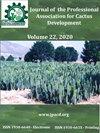芦荟叶片产量及凝胶品质研究发热管。F.在墨西哥北部灌溉制度下
IF 0.4
4区 农林科学
Q4 HORTICULTURE
Journal of the Professional Association for Cactus Development
Pub Date : 2022-08-17
DOI:10.56890/jpacd.v24i.497
引用次数: 0
摘要
芦荟叶的衍生物[aloe vera(L.)Burm.f],如凝胶、果汁和粉末,在工业部门受到高度重视。本研究评估了不同土壤水分含量对墨西哥干旱地区芦荟生长、生产和凝胶质量的影响。该研究采用随机完全区组设计,共有三个重复。根据田间持水量百分比,试验了三种灌溉处理:土壤含水量分别为0.12±0.02 m3 m-3(对照)、0.18±0.02 m3 m3 m-3和0.24±0.02 m3m-3,其平均值(±标准差)分别为42%、72%和100%。用72%的FC处理的芦荟植株比用42%的田间容量处理的芦荟株高和叶宽更大,而用100%FC处理的植株叶片最长(56.1厘米)和最厚(1.5厘米)。以72%或100%的田间容量灌溉的芦荟植物产生了最新鲜的叶片生物量和凝胶。相反,在42%的田间处理下生长的植物具有最高的芦荟凝胶pH值(4.94)、总可溶性固体(1.77°Brix)、灰分含量(0.62%)、甲醇沉淀固体(1.24%)和总固体(1.88%)。尽管最低的土壤含水量(田间容量的42%)降低了植物和叶片的生长以及叶片和凝胶的产量,但凝胶质量得到了提高,达到了国际市场要求的凝胶质量标准。本文章由计算机程序翻译,如有差异,请以英文原文为准。
Leaf production and gel quality of Aloe vera (L.) Burm. F. under irrigation regimens in northern Mexico
The derivatives of aloe plant leave [Aloe vera (L.) Burm. f.], such as gel, juice, and powder, are highly appreciated in the industrial sector. This study evaluated the effect of different soil moisture contents on the growth, production, and gel quality of aloe grown in an arid region of Mexico. The study was conducted in a randomized complete block design with three replicates. Base on the percentage of field capacity (FC), three irrigation treatments were tested: 42%, 72%, and 100% of FC corresponding, on average (± standard deviation), to 0.12 ± 0.02 m3 m-3 (as control), 0.18 ± 0.02 m3 m-3, and 0.24 ± 0.02 m3 m-3 of soil water content, respectively. Aloe plants watered with 72% of FC had greater plant height and leaf width than plants watered at 42% of field capacity, while plants with 100% of FC treatment had the longest (56.1 cm) and thickest (1.5 cm) leaves. Aloe plants irrigated at either 72% or 100% of field capacity produced the freshest leaf biomass and gel. In contrast, plants grown at 42% of field capacity treatments had the highest pH (4.94), total soluble solids (1.77 °Brix), ash content (0.62%), methanol-precipitated solids (1.24%), and total solids (1.88%) of aloe gel. Even though the lowest soil moisture content (42% of field capacity) reduced plant and leaf growth and leaf and gel yields, gel quality was enhanced, meeting the gel quality standards demanded by the international market.
求助全文
通过发布文献求助,成功后即可免费获取论文全文。
去求助
来源期刊

Journal of the Professional Association for Cactus Development
Agricultural and Biological Sciences-Plant Science
CiteScore
1.10
自引率
33.30%
发文量
10
期刊介绍:
The editors of the Journal of the Professional Association for Cactus Development, are very excited to be a part of the excellent editorial committee and to work together to create the synergism between scientists, growers, legislators, and business people so vital to the development of this industry to serve the people of arid lands.
 求助内容:
求助内容: 应助结果提醒方式:
应助结果提醒方式:


